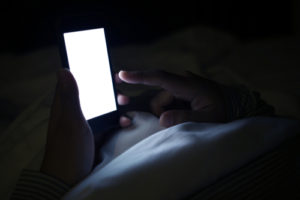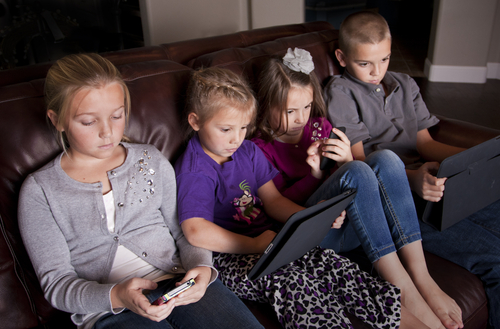People are addicted to their smartphones now more than ever. Most young adults are spending much of their days being glued to screens – from texting to social media and more. People are alienating themselves from one another because of this without even being aware of it.
The inability to break free of digital distractions is causing many people to be less creative, less productive, less friendly – but also lonelier. In this “connected” world, we have everything in the palms of our hands, and yet in many ways we are more alone than ever. How do we combat that? Let’s find out!
The Screen Time Epidemic
Some people spend up to 10 hours a day glued to their phones. It’s common to check one’s phone every 5-10 minutes. Screen time is rising rapidly and that has a lot of negative consequences, including:
- Decreased productivity
- Increased feelings of loneliness, depression, etc.
- Loss of sleep
Fortunately, the world is becoming more aware of this disturbing trend. The big tech players (Apple, Samsung, Google et al) are already finding ways to give mobile device users a way to measure and control screen time. This empowers us to cut back and dedicate valuable time to more important things like family, friends, loved ones and our everyday lives.
How to measure screen time

Screen time is defined as the time a person spends on a mobile device.
Many mobile device users have no clue that they are spending so much of their time on their phones, perhaps because they don’t see this as a problem. That’s how we can end up being addicted to their phones. If we don’t control our screen time, it can pose a serious risk to our well-being.
Mobile devices are also endangering children since children who spend a lot of time on mobile devices are less creative, less productive, less likely to socialize. When people are so busy with their phones, they fail to do other, more important things that aren’t related to technology or to being online.
Many people aren’t in control of how much time they spend on mobile apps because they don’t have an insight into how much of their time gets irreversibly consumed by their mobile device addiction.
With that in mind, if we have more awareness of this and exercise more control over our screen time, it might just lead to making a change in smartphone usage. Healthier phone habits can help us improve the quality of our lives.
The question remains: how to measure screen time? Apple is the first to break the ice and do something about this alarming new addiction. Their Screen Time app provides a data-driven insight into phone usage to each device owner.
Users can now get a full report on how they use their devices. Based on usage, the activated app gathers data and gives results such as how often users are checking their phones, the time they’ve spent on specific apps and so on. The app includes all the devices a user is logged into (unless you’re doing work or homework on a PC, for example, but use an iPhone – then your PC time might not get counted in the Screen Time stats).
What does this mean?
The Screen Time app is there to help mobile users snap out of their addiction and realize how much time they spend on their phones when they could be doing something much more productive and creative. Uncontrolled mobile usage is a serious risk, especially for youth.
It prevents young people from developing a sense of creativeness and productiveness. They won’t be productive if they can find anything with a few taps of their fingers which leave serious consequences in their lives when they grow up.

The problem with smartphone addiction is that its effects are psychological. That means that certain psychological conditions such as anxiety are directly correlated to phone addiction. That’s why people who are phone addicts tend to have low self-esteem and problems with depression and anxiety.
The more we spend time on their phones, the more we tend to avoid socialization and human interaction. The best solution to treat this condition is to limit or cut down screen time per day – that’s what will help get us back to reality and start feeling better.
Since mobile addiction is real and it’s getting worse, the Screen Time app was designed as a means that is supposed to help those mobile users who spend 10+ hours glued to their screens each day. That’s why this app comes with multiple features, all customizable to suit the preferences of each user. It’s possible to change your mobile phone habits by using these features:
- App limits – set your time limits for phone usage each day by hand. When the time is up, you’ll get a notification that your daily app limit is about to expire. This is aimed at those who tend to spend huge amounts of time on social media apps and are literally unable to spend some time apart from their phones.
- Downtime – set the exact apps you want to make accessible with this useful feature to significantly cut down the amount of time you spend on your phone every day. By limiting yourself to using only specific apps during your Downtime, you’ll significantly reduce your overall phone usage.
- Family sharing – this is an extremely useful feature for parents whose children spend way too much time on their phones. A parent can be the Family Manager and check on their kids using this feature as it offers insight into the devices their children use and their screen time usage.
Why cut back on screen time
The reasons for cutting back on screen time are numerous – but one of the biggest reasons might just be to take your productivity back. Another excellent reason could be the well-being of the user. If a young adult is spending way too much time on a phone, they won’t be able to find out what makes them tick or where their interests lie, since technology will effectively do this kind of ‘thinking’ for them.
This will only give a wrong impression about who we are and what we are supposed to be, however, rather than figuring out that part on our own. Kids who significantly cut their screen time get more cheerful and friendly; they perform better at school and outside of it, and so on. Some people get so hooked on their phones that they need to take serious action to deal with their addiction.
While phone addiction isn’t as serious as alcohol or drug addiction, it can still have lots of negative impacts, especially on young adults. This can be avoided by adopting healthy habits and techniques that will limit your screen time and help you cut back if needed. People who cut back tend to feel much better, less anxious when interacting with other people and they can focus on things that really matter to them.
Turn off all notifications, delete social media apps, stop taking your phone to the bathroom and discipline yourself to not consult your phone for every little thing that crosses your mind. Here are some excellent things you should stop doing to cut back on screen time:
- Stop Googling everything as this will help maintain a lively conversation. Enjoy a good time simply because you don’t need to know everything really; life will go on.
- Stop taking photos every few minutes – taking photos nonstop isn’t going to help you make good memories. Studies have proven that constant photo-taking prevents your brain from forming detailed memories during experiences. If you don’t take photos every few minutes, you’ll have a better memory of the entire experience.
- You don’t need to take your phone everywhere you go – leave your phone behind whenever you can. Go for lunch, take a hike, spend some time with your pet, friends, family or loved ones but without your phone as you will feel better for it.
How to cut back your screen time

To be able to cut back your screen time, you need to get a comprehensive look into your phone habits. When you determine that the usage is the highest, you can take some actions to reduce your usage. The most important thing is that you understand how to utilize this data as this will help you turn your insights into clear and fruitful actions.
The Screen Time app provides useful features that help you review your usage data so that you can improve your digital habits and make better use of your time. Set your goals but focus on reasons for wanting to limit your device usage in your mind. If you’re spending too much time at work glancing at your phone, cut back.
If your kids aren’t doing their homework because they’re spending too much time on social media, have them cut back. If your current measures of precaution aren’t giving results, refine and repeat.
Getting professional help can also be an effective solution.
Everything starts with you and your will to change your digital habits.
If you’re ready to make changes in your life or help a loved one, contact us today to find out more and book an appointment with one of our counsellors.


